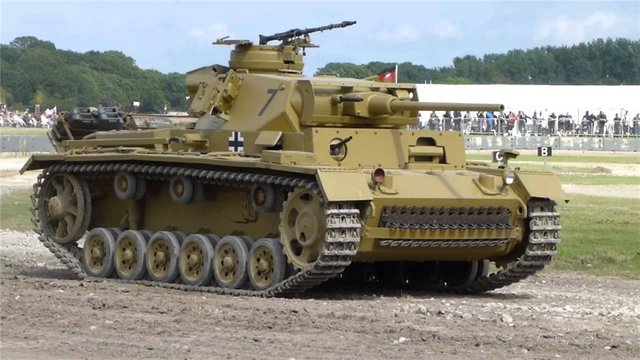Best tanks of World War II
During World War II tanks played a crucial role in the battles and operations. It is very hard to choose, what tank is the best, so the places in this top list are based on time periods of tanks building and others reasons like an active participation in conflicts and its value in a war.
Panzerkampfwagen III (PzKpfw III)
PzKpfw III, better known as the T-III - light tank with 37 mm gun. Booking from all angles - 30 mm. The main quality - speed (40 km / h on the highway). Thanks Carl Zeiss good optics, ergonomic workstations of a crew and the presence of the radio station, T-III could successfully fight with the much heavier machines. But with the advent of new enemies, T-III problems opened more clearly. The Germans replaced the 37 mm cannon with a 50 mm cannon and a covered tank with a mounted screens - temporary measures have given results, T-III was in a line several years. By in 1943, production of the T-III was discontinued due to complete exhaustion of its resources for modernization. In general German industry produced 5000 T-III.
Panzerkampfwagen IV (PzKpfw IV)
A much more serious look had PzKpfw IV, which became the most massive tank of Panzerwaffe - the German industry produced 8700 cars. Combining all the advantages of a lighter T-III, T-IV had high firepower and protection - the thickness of the front plate is gradually brought to 80 mm, and the gun-shells of its 75 mm long-barreled weapon pierced the armor of enemy tanks, as a foil. Weaknesses machine - too thin boards and stern (only 30 mm in the first versions), the designers ignored the slope of armor plates for the sake of ease crew work. Panzer IV - the only German tank, was in series production all Second World War and became the most mass tank the Wehrmacht. His popularity among the German tank was comparable with the popularity of the T-34 and "Sherman" from the Americans. Good structurally and extremely reliable in operation, this war machine in the full sense of the word was "workhorse" of Panzerwaffe.
KV-1 Klim Voroshilov
The main advantage of KV was armor - 75 mm steel in all projections. German 37 mm anti-tank guns did not make any damage to KV, and 50 mm guns – could hit it only in 500 meters. Also KV had good and powerfull long-barreled 76 mm cannon F-34 (ZIS-5), which hit the German tanks of theinitial stage of the war from a distance of 1.5 kilometers. Wide tracks and 600 hp diesel engine provides good flotation and decent mobility for this heavy tank. The main disadvantages were bad overview and weak transmission on the firs KV tanks . Crews KV staffed mainly by officers, only drivers could be petty officers. The level of their training was better than the level of others crews. They fought more skillfully, so remember the Germans ... Soviet industry produced 3539 KV.
Т-34
T-34 in 1941 was a very innovative tank: the 500-hp diesel engine, a unique scheme of booking with rational angles of slopes, 76 mm cannon F-34 (like was set on KV) and wide tracks - all these technical solutions provide the T-34 the optimum ratio mobility, firepower and protection.
Panzerkampfwagen VI «Tiger I» Ausf E
A lot of historians think, that the main goal of the Tiger was to fight with enemy tanks. However, its design is very consistent to the decision of this problem. In the early days of World War II German military doctrine was aggressive. It was based on a fast and maneuverable PZ 2,3,4 which could quickly destroyed enemy defenses and support the infantry attack. Later, when the situation changed at the front, the Germans needed a tank that can take a punch, defend, successfully destroy enemy tanks, and then go to a counterattack. Thus, the tank "Tiger" was a tool to combat enemy tanks, whether in defense or attack.
Tiger was incredibly strong for its time. He had a huge number of advantages: a great gun (8.8 cm KwK 36), which allows to fight with enemy at 2000 meters, excellent armor (100 mm on the front, 80 on the sides), which provides strong protection for combat car, a high-tech sight aim (TZF-9b by Carl Zeiss) and high-quality radio. Tiger was also quite spacious tank, which has a positive effect on the working conditions of the crew. The main downside of the machine include a general high cost - 800,000 Reichsmarks for a Tiger and unreliable, but the progressive chess-suspension - it required a lot of time to repair.
Tiger has been one of the most horrible opponent. His appearance instilled fear and trembling, he became one of the most recognizable symbols of the Second World War. Total 1354 tanks were produced. The most famous tankers who fought on this monster, were Kurt Knispel, Otto Carius, Michael Wittmann and Martin Shroif.!
Thanks for attention.











Very informative, great post! We have a fantastic war museum here in town with quite a few awesome tanks!
Thank you!
History is very important!